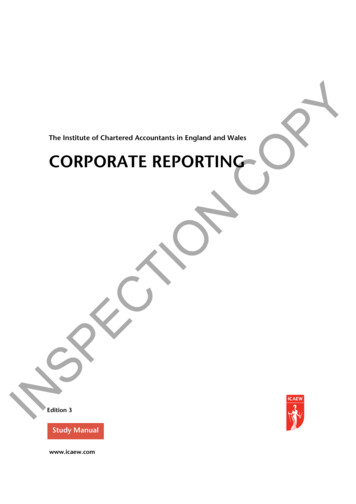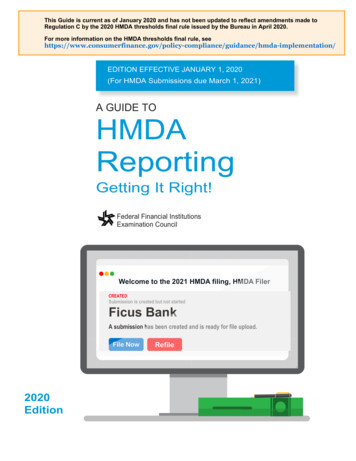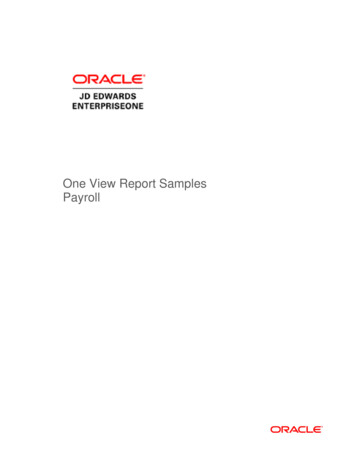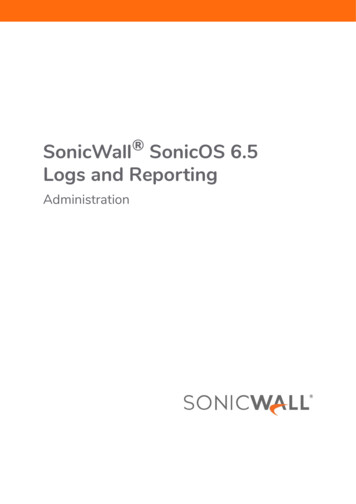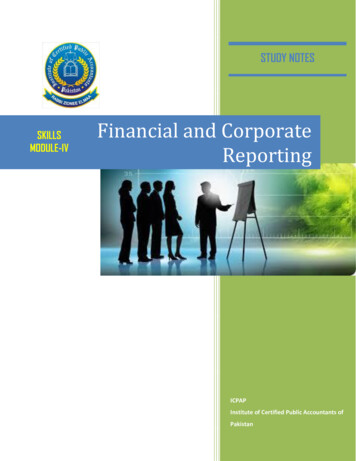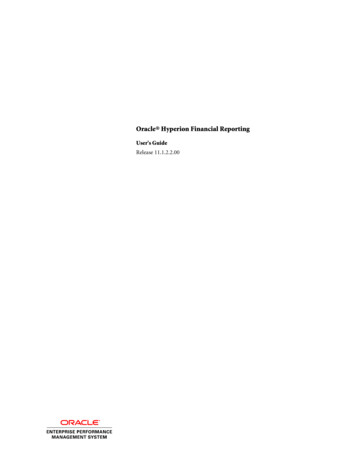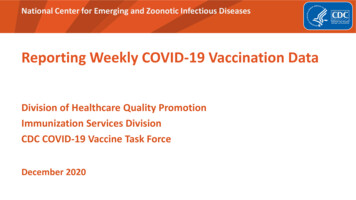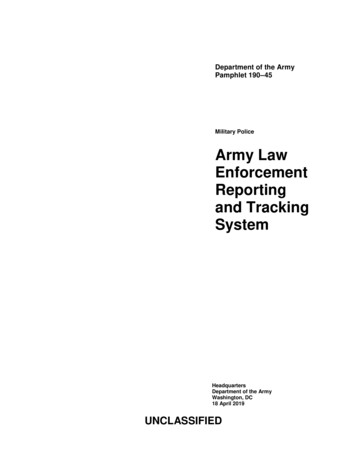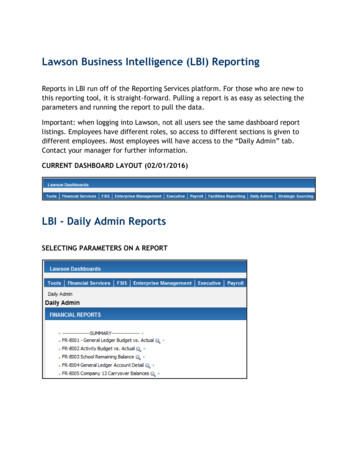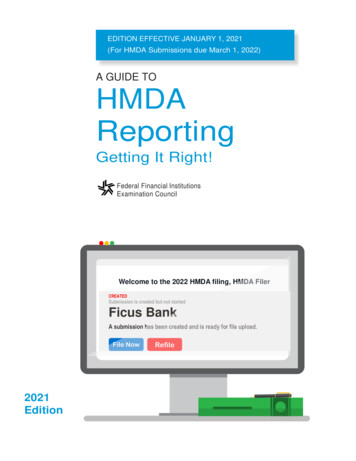
Transcription
EDITION EFFECTIVE JANUARY 1, 2021(For HMDA Submissions due March 1, 2022)A GUIDE TOHMDAReportingGetting It Right!Federal Financial InstitutionsExamination CouncilWelcome to the 2022 HMDA filing, HMDA FilerCREATEDSubmission is created but not startedFicus BankA submission has been created and is ready for file upload.File Now2021EditionRefile
2021EditionA GUIDE T O HMDAReporting: Getting It Right!Edition effective January 1, 2021 (for HMDA submissions due March 1,2022)This edition of the Guide is the comprehensive edition for the 2021 calendaryear data (due March 1, 2022). Appendices include:Last Edited:March 22, 2021 Overview of Data Requirements Chart; HMDA Small Entity Compliance Guide; Instructions on Collection of Data on Ethnicity, Race, and Sex; Step-by-Step Charts Summarizing Transactional and Institutional Coverage; Partial Exemptions Charts; Data Fields and Data Points Chart; Regulation C, 12 CFR Part 1003; Official Interpretations to Regulation C, 12 CFR Part 1003; Federal HMDA Reporting Agencies; and HMDA Poster.
ContentsForeword . ISummary of Requirements . 1Institutional Coverage: Who Must Report? . 1Transactional Coverage: What Is Reported? . 10Compilation of Reportable Data: What Is Reported? . 32Recording, Reporting, and Disclosure: When is it Reported? . 34Appendices . 42Overview of Data Requirements Chart . A-1HMDA Small Entity Compliance Guide . B-1Instructions on Collection of Data on Ethnicity, Race, and Sex . C-1Institutional Coverage Chart . D-1Transactional Coverage Chart . E-1Partial Exemptions Charts . F-1Data Fields and Data Points Chart . G-1Regulation C . H-1Official Interpretations to Regulation C . I-1Federal HMDA Reporting Agencies .J-1HMDA Poster . K-1
ForewordA Guide to HMDA Reporting: Getting It Right! will assist you in complying with theHome Mortgage Disclosure Act (HMDA) as implemented by the Consumer FinancialProtection Bureau’s Regulation C, 12 CFR Part 1003 (Regulation C). The purpose ofthis Guide is to provide an easy-to-use summary of certain key requirements. ThisGuide does not provide detailed information about the HMDA submission process, orfile, data, and edit specifications. Information about those topics may be found on theFFIEC’s Resources for HMDA Filers website, available at ffiec.cfpb.gov andwww.ffiec.gov/hmda/.The Foreword and Summary of Requirements sections of the Guide were developedby the Federal Financial Institutions Examination Council (FFIEC) — the Board ofGovernors of the Federal Reserve System (Board), the Consumer Financial ProtectionBureau (CFPB), the Federal Deposit Insurance Corporation (FDIC), the National CreditUnion Administration (NCUA), the Office of the Comptroller of the Currency (OCC),and the State Liaison Committee (SLC) — and the U.S. Department of Housing andUrban Development (HUD). The appendices include, in addition to Regulation C andits Official Interpretations, certain HMDA compliance materials developed and issuedexclusively by the CFPB and not by the FFIEC or its other member agencies.Financial institutions may wish to consult and rely upon additional complianceresources that their Federal supervisory agencies may offer. Contact information foreach agency is available in Appendix J.This edition of the Guide incorporates the amendments made to HMDA by the DoddFrank Wall Street Reform and Consumer Protection Act (Dodd-Frank Act)1 and the1I Dodd-Frank Wall Street Reform and Consumer Protection Act, Public Law 111-203, 124 Stat.1376, 2097-2101 (2010).2021 EDITION A GUIDE TO HMDA REPORTING: GETTING IT RIGHT!
Economic Growth, Regulatory Relief, and Consumer Protection Act (The 2018 Act).2The Dodd-Frank Act amended HMDA, transferred rulewriting authority to the CFPBand expanded the scope of information that must be collected, reported, and disclosedunder HMDA, among other changes. In October 2015, the CFPB issued the 2015HMDA Rule implementing the Dodd-Frank Act amendments to Regulation C.3 The2015 HMDA Rule modified the types of institutions and transactions subject toRegulation C, the types of data that institutions are required to collect, and theprocesses for reporting and disclosing the required data.4On August 24, 2017, the CFPB issued a 2017 HMDA Rule to further amendRegulation C to make technical corrections and clarify and amend certain requirementsadopted by the 2015 HMDA Rule.5The 2018 Act amended HMDA by adding partial exemptions from HMDA’srequirements for certain transactions made by certain insured depository institutions2Public Law, No. 115-174, 132 Stat. 1296 (2018). The President signed the Economic Growth,Regulatory Relief, and Consumer Protection Act into law on May 24, 2018.3Home Mortgage Disclosure (Regulation C), 80 FR 66128 (Oct. 28, 2015) (2015 HMDA Rule).42015 HMDA Rule, 80 FR 66128-29. For more information on the specific changes made bythe 2015 amendments to Regulation C, review the Executive Summary for the 2015 HMDARule, available at www.consumerfinance.gov/documents/5218/201510 cfpb hmdaexecutive-summary.pdf. Further, Section 2 of the HMDA Small Entity Compliance Guide,available in Appendix B of this Guide, also provides an overview of these changes.5Home Mortgage Disclosure (Regulation C), 82 FR 43088 (Sept. 13, 2017) (2017 HMDARule). For more information on the specific changes made by the 2017 technical correctionsand clarifications to Regulation C, review the Executive Summary, available atwww.consumerfinance.gov/documents/5206/201707 cfpb hmda-executivesummary.pdf.2021 EDITION A GUIDE TO HMDA REPORTING: GETTING IT RIGHT! II
and insured credit unions. On August 31, 2018, the CFPB issued a 2018 HMDA Ruleto implement and clarify changes made by the 2018 Act.6On October 10, 2019, the Bureau issued a 2019 HMDA Rule to extend the temporarythreshold for reporting data about open end lines of credit and implement and furtherclarify the partial exemptions created by the 2018 Act.7On April 16, 2020, the Bureau issued a 2020 HMDA Rule to adjust the thresholds forreporting data about closed-end mortgage loans, effective July 1, 2020, and thethresholds for reporting data about open-end lines of credit, effective January 1, 2022.8III 683 FR 45325 (Sept. 7, 2018).784 FR 57946 (Oct. 29, 2019).885 FR 28364 (May 12, 2020).2021 EDITION A GUIDE TO HMDA REPORTING: GETTING IT RIGHT!
The Summary of Requirements reviews HMDA’s purposes and data collection,reporting, and disclosure requirements. It provides a high level summary of: The institutions covered by Regulation C. The transactions covered by Regulation C. The information that covered institutions are required to collect, record, andreport. The requirements for reporting and disclosing data.This Guide is not a substitute for HMDA or Regulation C. Regulation C and itsofficial interpretations (also known as the commentary) are the definitive sources ofinformation regarding their requirements. Regulation C and its commentary areavailable in Appendix H and I of this Guide and king/regulations/1003/.Additionally, this Guide is not a substitute for the requirements for filing the reportabledata. The Filing Instructions Guide (FIG) is the definitive source for informationregarding the filing requirements and is available at ffiec.cfpb.gov.99The Federal HMDA reporting agencies (the Board, CFPB, HUD, FDIC, NCUA, and OCC),referred to as the “appropriate Federal agency” in Regulation C, agreed that, beginning onJanuary 1, 2018, all HMDA filers will file their HMDA data with the CFPB. The CFPB willprocess the HMDA data for the Federal HMDA reporting agencies and the FFIEC, andprepare and make available data products to the general public on behalf of the FederalHMDA reporting agencies and the FFIEC. For HMDA data reporting beginning in 2018, aweb-based data submission and edit-check system (the HMDA Platform) is available toprocess HMDA data. For a financial institution to submit its file, it must be in pipe delimitedformat. For more information on the format and how to submit the file, review the FilingInstructions Guide.2021 EDITION A GUIDE TO HMDA REPORTING: GETTING IT RIGHT! IV
FeedbackThe FFIEC welcomes suggestions for changes or additions that might make this Guidemore helpful.Write to:FFIEC3501 Fairfax DriveRoom B-7081aArlington, VA 22226Send an e-mail to: GettingItRightGuide@cfpb.govQuestionsIf, after reviewing the resources in this Guide, you have a question regarding aspecific provision of the regulation, or have questions about how to file HMDA data,please email HMDAHELP@cfpb.gov with your specific question, identifying the filingyear you are referencing, and, when applicable, the section(s) of the regulationrelated to your question. You can also submit the inquiry online using the formavailable at hmdahelp.consumerfinance.gov. The information you provide willpermit the CFPB to process your request or inquiry. You may also contact yourappropriate Federal HMDA reporting agency (see Appendix J to this Guide).V 2021 EDITION A GUIDE TO HMDA REPORTING: GETTING IT RIGHT!
Summary ofRequirementsGenerally, this Guide will point you to the relevant resources that discuss: The institutions covered by Regulation C. The transactions covered by Regulation C. The information that covered institutions are required to collect, record, andreport. InstitutionalThe requirements for reporting and disclosing data.The material can be found after the introduction in the referenced appendix section.Coverage Coverage GenerallyInstitutional Coverage: Who Must Report? Coverage Tests Exemptions Based onState LawINSTITUTIONAL COVERAGE GENERALLYAn institution is required to comply with Regulation C only if it is a “financial institution” Mergers andas that term is defined in Regulation C. The definition of financial institution includesAcquisitionsboth depository financial institutions and nondepository financial institutions, as thoseTransactionalCoverageterms are separately defined in Regulation C. 12 CFR 1003.2(g).An institution uses these two definitions, which are outlined below, as coverage tests todetermine whether it is a financial institution that is required to comply with RegulationCompilation ofC. For the purposes of this Guide, the term “financial institution” refers to an institutionReportable Datathat is either a depository financial institution or a nondepository financial institutionthat is subject to Regulation C.Recording, Reporting,and DisclosureWhere to Look: Regulation C’s institutional coverage criteria are found within thedefinition of “financial institution,” located at 12 CFR 1003.2(g) and the associated commentary,available in Appendix H and I of this Guide. You may also want to review section 3 of theHMDA Small Entity Compliance Guide in Appendix B and the Institutional Coverage Chart inAppendix D of this Guide.1 2021 EDITION A GUIDE TO HMDA REPORTING: GETTING IT RIGHT!
Summary ofRequirementsINSTITUTIONAL COVERAGE TESTSDEPOSITORY FINANCIAL INSTITUTIONSA bank, savings association, or credit union is a depository financial institution andsubject to Regulation C if it meets ALL of the following:1. Asset-Size Threshold. On the preceding December 31, the bank, savingsInstitutionalassociation, or credit union had assets in excess of the asset-size threshold publishedCoverageannually in the Federal Register, included in the official interpretations, 12 CFR Part Coverage Generally Coverage Tests Exemptions Based onState Law Mergers andAcquisitionsTransactionalCoverage1003, Comment 2(g)-2, and posted on the CFPB’s website. 12 CFR 1003.2(g)(1)(i).The phrase “preceding December 31” refers to the December 31 immediatelypreceding the current calendar year. For example, in 2021, the preceding December31 is December 31, 2020. Comment 2(g)-1.2. Location Test. On the preceding December 31, the bank, savings association, orcredit union had a home or branch office located in a metropolitan statistical area(MSA). 12 CFR 1003.2(g)(1)(ii).For purposes of this location test, a branch office for a bank, savings association, orcredit union is an office: (a) of the bank, savings association, or credit union (b) that isCompilation ofconsidered a branch by the institution’s Federal or State supervisory agency. ForReportable Datapurposes of Regulation C, an automated teller machine or other free-standingelectronic terminal is not a branch office regardless of whether the supervisory agencyRecording, Reporting,would consider it a branch. 12 CFR 1003.2(c)(1). A branch office of a credit union isand Disclosureany office where member accounts are established or loans are made, whether or notan agency has approved the office as a branch. Comment 2(c)(1)-1.3. Loan Activity Test. During the preceding calendar year, the bank, savingsassociation, or credit union originated at least one home purchase loan or refinancingof a home purchase loan secured by a first lien on a one-to four-unit dwelling. 12 CFR1003.2(g)(1)(iii). For more information on whether a loan is secured by a dwelling, is ahome purchase loan, or is a refinancing, see 12 CFR 1003.2(f), (j), and (p) and2021 EDITION A GUIDE TO HMDA REPORTING: GETTING IT RIGHT! 2
Summary ofassociated commentary; and Sections 4.1.1.2 and 5.7 of the HMDA Small EntityRequirementsCompliance Guide available in Appendix B of this Guide.4. Federally Related Test. The bank, savings association, or credit union:a. Is federally insured; orb. Is federally regulated; orInstitutionalc. Originated at least one home purchase loan or refinancing of a home purchaseCoverageloan that was secured by a first lien on a one- to-four-unit dwelling and also (i) Coverage Generallywas insured, guaranteed or supplemented by a Federal agency or (ii) was Coverage Testsintended for sale to the Federal National Mortgage Association (Fannie Mae) or Exemptions Based onthe Federal Home Loan Mortgage Corporation (Freddie Mac).12 CFR 1003.2(g)(1)(iv).State Law Mergers andAcquisitionsTransactionalCoverage5. Loan-Volume Threshold. The bank, savings association, or credit union meets orexceeds either the closed-end mortgage loan or the open-end line of credit loanvolume threshold in each of the two preceding calendar years. Effective July 1, 2020,a bank, savings association, or credit union that originated at least 100 closed-endmortgage loans in each of the two preceding calendar years, or originated at least 500open-end lines of credit in each of the two preceding calendar years meets or exceedsCompilation ofthe loan-volume threshold.10Reportable DataWhen the bank, savings association, or credit union determines whether it meetsRecording, Reporting,these loan-volume thresholds, it does not count transactions excluded byand Disclosure12 CFR 1003.3(c)(1) through (10) and (13). 12 CFR 1003.2(g)(1)(v). Closed-endmortgage loans, open-end lines of credit, and these excluded transactions arediscussed below in TRANSACTIONAL COVERAGE: WHAT IS REPORTED?.10Effective January 1, 2022, the open-end line of credit loan-volume threshold will be set at200 open-end lines of credit in each of the two preceding calendar years. See HomeMortgage Disclosure (Regulation C), 85 FR 28364 (May 12, 2020).3 2021 EDITION A GUIDE TO HMDA REPORTING: GETTING IT RIGHT!
Summary ofWhen determining if it meets the loan-volume thresholds, a bank, savings association,Requirementsor credit union only counts closed-end mortgage loans and open-end lines of creditthat it originated. Only one institution is deemed to have originated a specific closedend mortgage loan or open-end line of credit under Regulation C, even if two or moreinstitutions are involved in the origination process. Only the institution that is deemedto have originated the transaction under Regulation C counts it for purposes of theLoan-Volume Threshold. Comment 2(g)-5; see also Comments 4(a)-2 through -4.InstitutionalThese requirements are discussed below in TRANSACTIONS INVOLVING MULTIPLECoverageENTITIES. Coverage Generally Coverage Tests Exemptions Based onState Law Mergers andAcquisitionsRegulation C also includes a separate test to ensure that financial institutions thatmeet only the closed-end mortgage loan threshold are not required to report theiropen-end lines of credit, and that financial institutions that meet only the open-end lineof credit threshold are not required to report their closed-end mortgage loans.12 CFR 1003.3(c)(11) and (12).11 For more information, see HMDA Small EntityCompliance Guide, Section 4.1.2 available in Appendix B of this Guide.TransactionalCoverageCompilation ofReportable DataRecording, Reporting,and Disclosure11If a financial institution is required under Regulation C to report only closed-end mortgageloans, it may optionally report open-end lines of credit that are excluded because the financialinstitution does not meet the transactional threshold for open-end lines of credit but thatwould otherwise be covered loans. Similarly, if a financial institution is required underRegulation C to report only open-end lines of credit, it may optionally report closed-endmortgage loans that are excluded because the financial institution does not meet thetransactional threshold for closed-end mortgage loans but that would otherwise be coveredloans. However, if it chooses to optionally report either closed-end mortgage loans or openend lines of credit, the financial institution must report all such transactions that wouldotherwise be covered loans for that calendar year. Comments 3(c)(11)-2 and 3(c)(12)-2.2021 EDITION A GUIDE TO HMDA REPORTING: GETTING IT RIGHT! 4
Summary ofNONDEPOSITORY FINANCIAL INSTITUTIONSRequirementsUnder Regulation C, a for-profit mortgage-lending institution other than a bank,savings association, or credit union is a nondepository financial institution and subjectto Regulation C if it meets BOTH of the following:1. Location Test. The institution had a home or branch office in a metropolitanInstitutionalstatistical area (MSA) on the preceding December 31. 12 CFR 1003.2(g)(2)(i). TheCoveragephrase “preceding December 31” refers to the December 31 immediately precedingthe current calendar year. For example, in 2021, the preceding December 31 is CoverageDecember 31, 2020. Comment 2(g)-1 Coverage Tests Exemptions Based onState Law Mergers andAcquisitionsFor purposes of this location test, a branch office of a nondepository financialinstitution is any one of the institution’s offices at which the institution takes from thepublic applications for covered loans. A nondepository financial institution is alsodeemed to have a branch office in an MSA if, in the preceding calendar year, itreceived applications for, originated, or purchased five or more covered loans relatedTransactionalto property located in that MSA, even if it does not have an office in that MSA. 12 CFRCoverage1003.2(c)(2). Covered loans and applications for covered loans are discussed belowin TRANSACTIONAL COVERAGE: WHAT IS REPORTED?.Compilation ofReportable DataRecording, Reporting,and Disclosure2. Loan-Volume Threshold. The institution meets or exceeds either the closed-endmortgage loan-volume threshold or the open-end line of credit loan-volume thresholdin each of the two preceding calendar years. Effective July 1, 2020, an institution thatoriginated at least 100 closed-end mortgage loans in each of the two precedingcalendar years, or originated at least 500 open-end lines of credit in each of the twopreceding calendar years meets or exceeds the loan-volume threshold.12125 Effective January 1, 2022, the open-end line of credit loan-volume threshold will be set at200 open-end lines of credit in each of the two preceding calendar years. See HomeMortgage Disclosure Act (Regulation C), 85 FR 28364 (May 12, 2020).2021 EDITION A GUIDE TO HMDA REPORTING: GETTING IT RIGHT!
Summary ofWhen an institution determines whether it meets the loan-volume thresholds, it doesRequirementsnot count transactions excluded by 12 CFR 1003.3(c)(1) through (10) and (13). 12CFR 1003.2(g)(2)(ii).InstitutionalCoverage Coverage Generally Coverage Tests Exemptions Based onState Law Mergers andAcquisitionsClosed-end mortgage loans, open-end lines of credit, and these excluded transactionsare discussed below in TRANSACTIONAL COVERAGE: WHAT IS REPORTED?.When determining if it meets the loan-volume thresholds, an institution only countsclosed-end mortgage loans and open-end lines of credit that it originated. Only oneinstitution is deemed to have originated a specific closed-end mortgage loan or openend line of credit under Regulation C, even if two or more institutions are involved inthe origination process. Only the institution that is deemed to have originated thetransaction under Regulation C counts it for purposes of the loan volume threshold.TransactionalCoverageComment 2(g)-5; see also Comments 4(a)-2 through -4. These requirements arediscussed below in TRANSACTIONS INVOLVING MULTIPLE ENTITIES.Regulation C also includes a separate test to ensure that financial institutions thatCompilation ofmeet only the 100 closed-end mortgage loan threshold are not required to report theirReportable Dataopen-end lines of credit, and that financial institutions that meet only the 500 open-endline of credit threshold are not required to report their closed-end mortgage loans.Recording, Reporting,12 CFR 1003.3(c)(11) and (12).13 For more information, see the HMDA Small Entityand DisclosureCompliance Guide, Section 4.1.2 available in Appendix B of this Guide.13If a financial institution is required under Regulation C to report only closed-end mortgageloans, it may optionally report open-end lines of credit that are excluded because the financialinstitution does not meet the transactional threshold for open-end lines of credit but thatwould otherwise be covered loans. Similarly, if a financial institution is required underRegulation C to report only open-end lines of credit, it may optionally report closed-endmortgage loans that are excluded because the financial institution does not meet thetransactional threshold for closed-end mortgage loans but that would otherwise be coveredloans. However, if it chooses to optionally report either closed-end mortgage loans or openend lines of credit, the financial institution must report all such transactions that wouldotherwise be covered loans for that calendar year. Comments 3(c)(11)-2 and 3(c)(12)-2.2021 EDITION A GUIDE TO HMDA REPORTING: GETTING IT RIGHT! 6
Summary ofRequirementsEXEMPTIONS BASED ON STATE LAWRegulation C provides that financial institutions may apply for an exemption fromcoverage. Specifically, the CFPB may exempt a State-chartered or State-licensedInstitutionalfinancial institution if the CFPB determines that the financial institution is subject to aCoverageState disclosure law that contains requirements substantially similar to those imposed Coverage Coverage Tests Exemptions Based onState Law Mergers andAcquisitionsTransactionalCoverageCompilation ofReportable DataRecording, Reporting,and Disclosureby Regulation C and adequate enforcement provisions. Any State-licensed or Statechartered financial institution or association of such institutions may apply to the CFPBfor an exemption. An exempt institution shall submit the data required by State law toits State supervisory agency. 12 CFR 1003.3(a). A financial institution that loses itsexemption must comply with Regulation C beginning with the calendar year followingthe year for which it last reported data under the State disclosure law. 12 CFR1003.3(b).MERGERS AND ACQUISITIONSAfter a merger or acquisition, the surviving or newly formed institution is subject toRegulation C if it satisfies the coverage criteria for either a depository financialinstitution or a nondepository financial institution. See INSTITUTIONAL COVERAGE TESTS,above, and Section 3 of the HMDA Small Entity Compliance Guide available inAppendix B of this Guide.Annual reporting responsibility for the calendar year after a merger oracquisition. When determining whether the surviving or newly formed institution iscovered for the calendar year after a merger or acquisition, the surviving or newlyformed institution must consider the combined assets, locations, and lending activitiesof the surviving or newly formed entity and the merged or acquired entities or acquiredbranches. Comment 2(g)-3.Annual reporting responsibility for the calendar year of a merger or acquisition.The following discusses the applicability of Regulation C during the calendar year of amerger or acquisition:7 2021 EDITION A GUIDE TO HMDA REPORTING: GETTING IT RIGHT!
Summary ofRequirements1. If two institutions that are not subject to Regulation C merge but the newlyformed or surviving institution is subject to Regulation C, no data collection isrequired for the calendar year of the merger.2. When a branch office of an institution that is not subject to Regulation C isacquired by another institution that is not subject to Regulation C, and theacquisition results in the acquiring institution becoming subject to Regulation C,InstitutionalCoverageno data collection is required for the calendar year of the acquisition.3. If an institution that is subject to Regulation C and an institution that is notsubject to Regulation C merge, and the surviving or newly formed institution is Coveragesubject to Regulation C, for the calendar year of the merger, data collection is Coverage Testsrequired for covered loans and applications handled in the offices of the Exemptions Based onState Law Mergers andAcquisitionsTransactionalCoverageCompilation ofReportable DataRecording, Reporting,and Disclosureinstitution that was previously subject to Regulation C. For the calendar year ofthe merger, data collection is optional for covered loans and applicationshandled in offices of the institution that was not previously subject to RegulationC.4. When an institution that is subject to Regulation C acquires a branch office of aninstitution that is not subject to Regulation C, data collection is optional forcovered loans and applications handled by the acquired branch office for thecalendar year of the acquisition.5. If an institution that is subject to Regulation C and an institution that is notsubject to Regulation C merge and the surviving or newly formed institution isnot subject to Regulation C, data collection is required for covered loans andapplications handled prior to the merger in the previously covered institution’soffices. After the merger date, data collection is optional for covered loans andapplications handled in the offices of the institution that was previously covered.6. When an institution that is not subject to Regulation C acquires a branch officeof an institution that is subject to Regulation C but that acquisition does notresult in the acquiring institution becoming subject to Regulation C, datacollection is required for transactions of the acquired branch office that takeplace prior to the acquisition. Data collection by the acquired branch office is2021 EDITION A GUIDE TO HMDA REPORTING: GETTING IT RIGHT! 8
optional for transactions taking place in the remainder of the calendar year ofSummary ofRequirementsthe acquisition.7. If two or more institutions that are subject to Regulation C merge and thesurviving or newly formed institution is also subject to Regulation C, datacollection is required for the entire calendar year of the merger. The survivingor newly formed financial institution files either a consolidated submission orseparate submissions for that calendar year.Institutional8. When one institution subject to Regulation C acquires a branch office of anotherCoveragecovered institution, data collection is required for the entire calendar year of the Coveragemerger. Data for the acquired branch office may be submitted by either Coverage Testsfinancial institution. Comment 2(g)-4. Exemptions Based onCHANGES TO APPROPRIATE FEDERAL HMDA REPORTING AGENCY OR TINState Law Mergers andAcquisitionsUnder Regulation C, if the appropriate Federal HMDA reporting agency for a financialinstitution changes, the financial institution must identify its new appropriate FederalHMDA reporting agency in its annual submission for the year of the change. ForTransactionalexample, if a financial institution’s appropriate Federal HMDA reporting agencyCoveragechanges in February 2021, it must identify its new appropriate Federal HMDAreporting agency beginning with the annual submission of its 2021 data by March 1,Compilation ofReportable DataRecording, Reporting,and Disclosure2022.If a financial institution obtains a new Tax Identification Number (TIN), it shouldprovide the new number in its subsequent data submission. For example, if twofinancial institutions that previously report
2021 EDITION A GUIDE TO HMDA REPORTING: GETTING IT RIGHT! Foreword . A. Guide . to HMDA Reporting: Getting It Right! will assist you in complying with the Home Mortgage Disclosure Act (HMDA) as implemented by the Consumer Financial Protection Bureau’s Regulation C, 12
